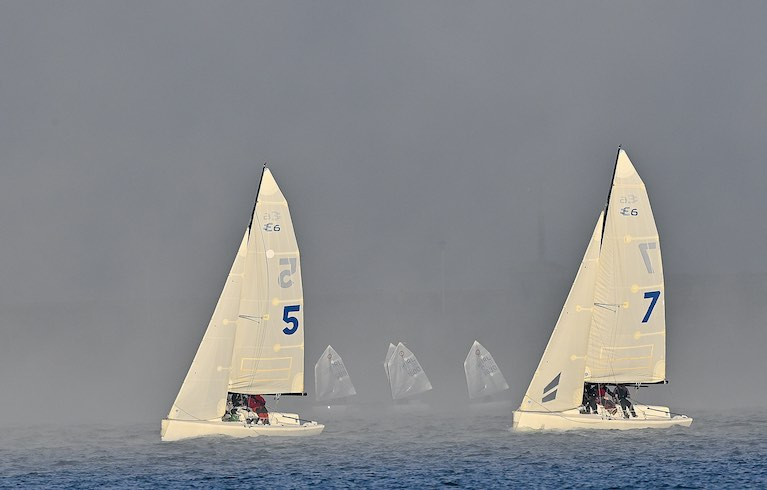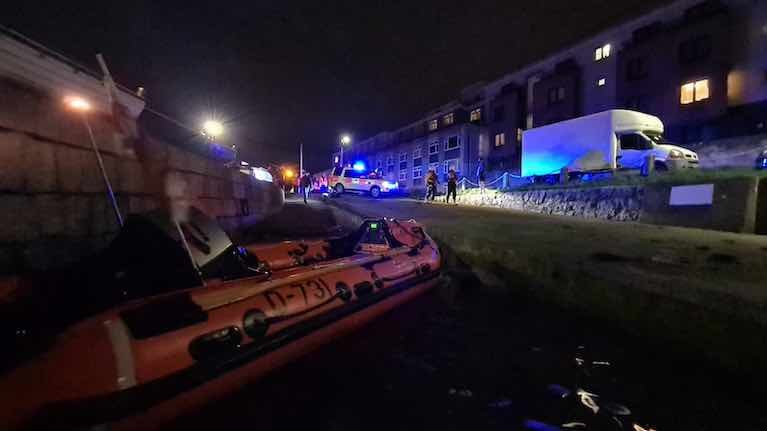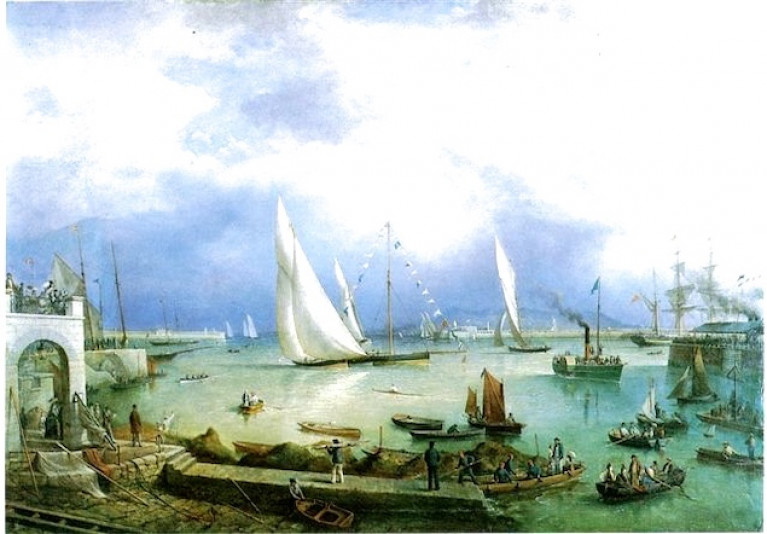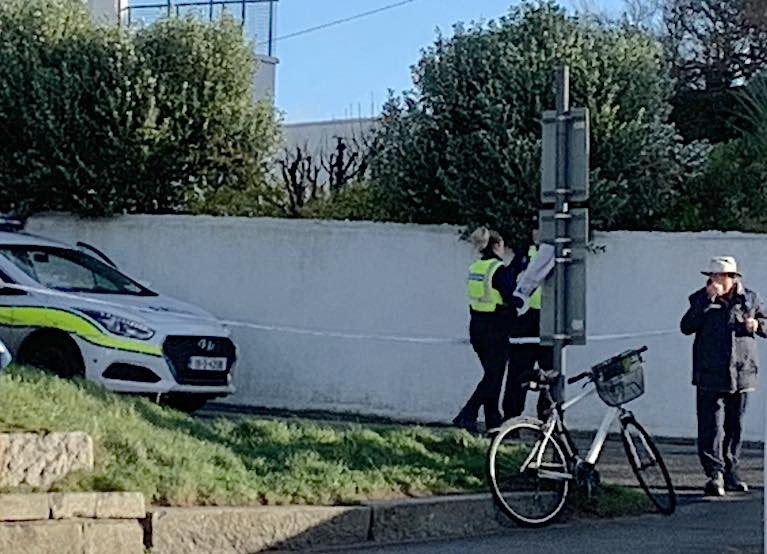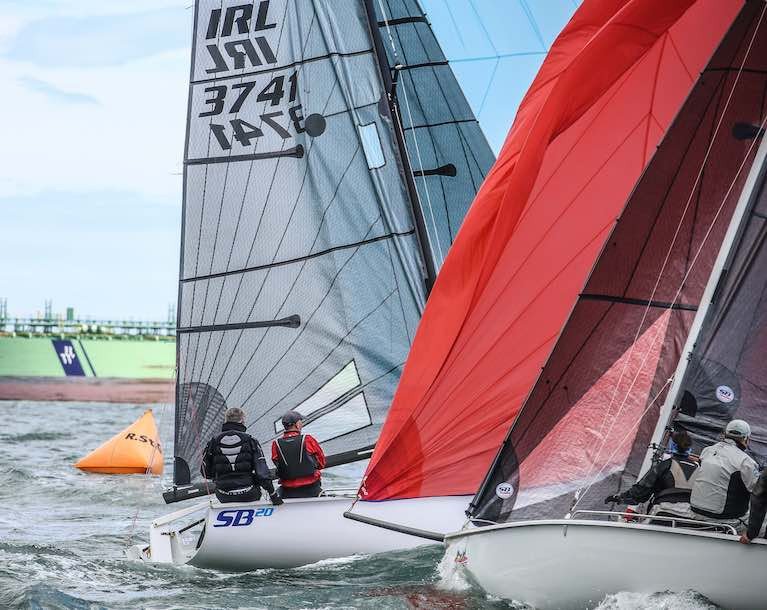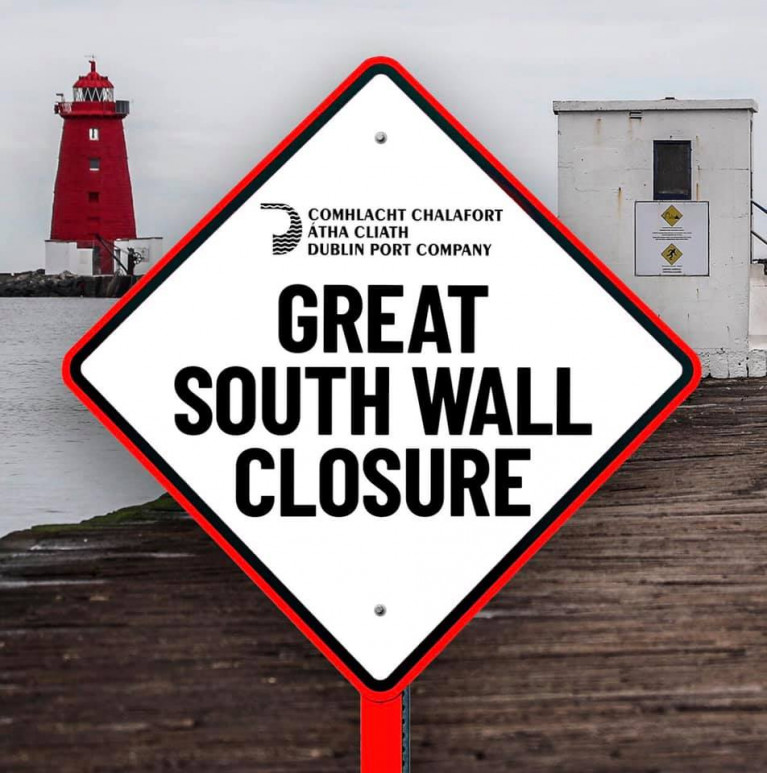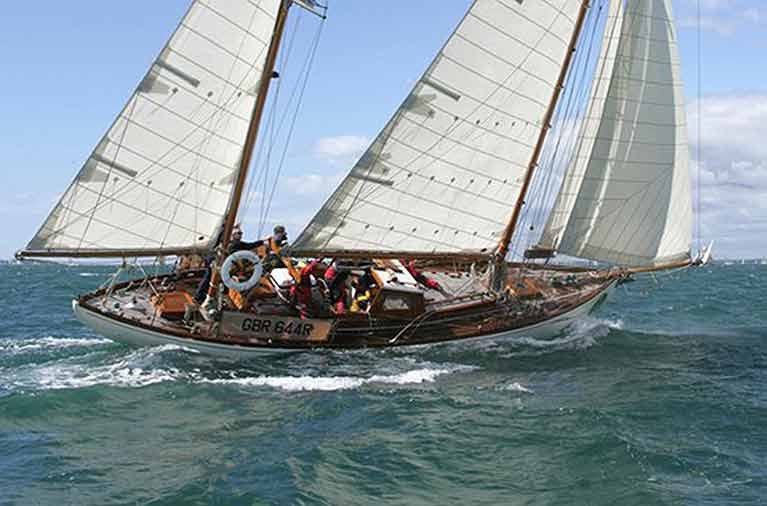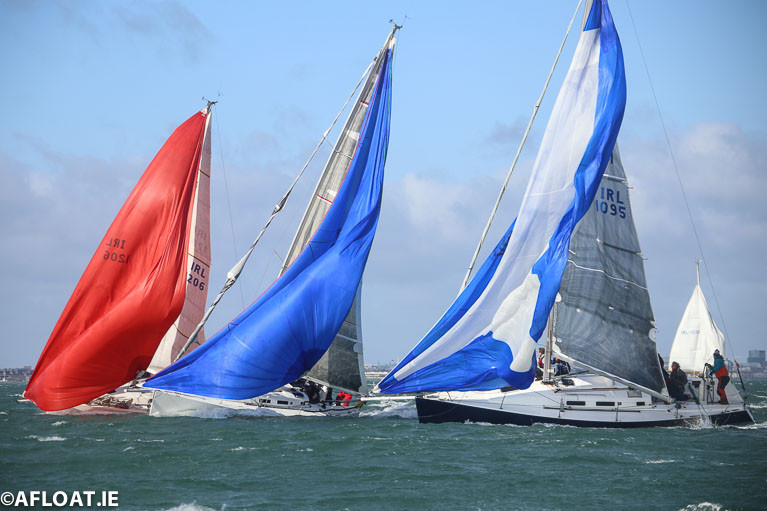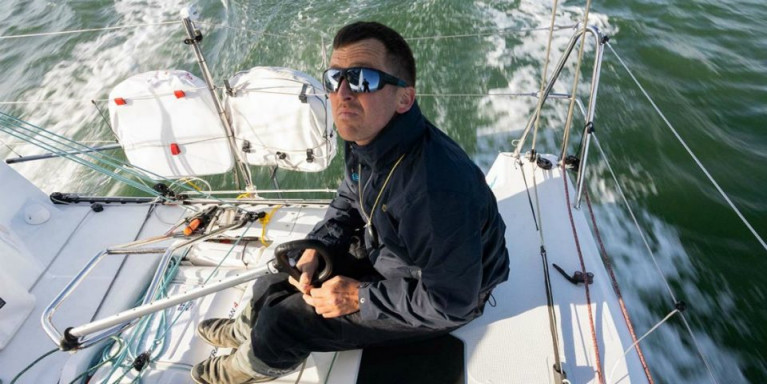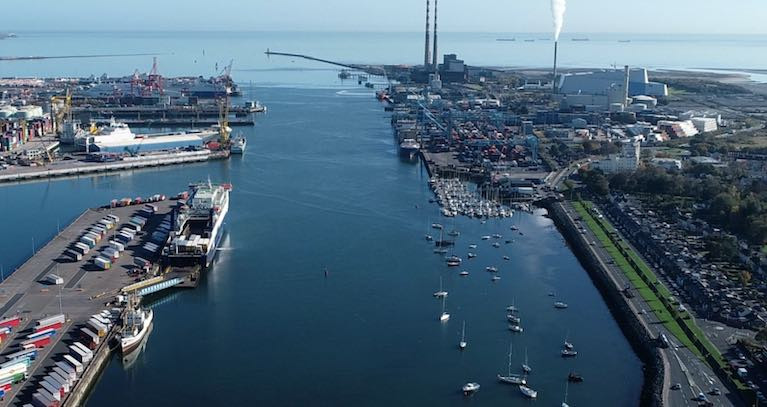Displaying items by tag: Dublin Bay
Dublin Bay Sea Fog is No Barrier for Dinghy & One Design Keelboat Sailing at Dun Laoghaire Harbour
There was plenty of sailing at Dun Laoghaire Harbour today as Laser, RS Aeros, Toppers and Optimist dinghy fleets enjoyed some great breezes even if a sea-fog reduced visibility for a time even within the harbour confines.
Up to 30 dinghies were afloat at the venue for the ideal 16-knot north-westerly training sessions that also saw the National Yacht Club's Elliot six-metre match racing keelboats on the water as well Flying Fifteens.
The much-anticipated DBSC Turkey Shoot training for cruiser-racers did not take place on the Bay due to COVID-19 restrictions.
 A safety RIB on patrol in Dun Laoghaire Harbour as Optimist dinghies are shrouded in mist
A safety RIB on patrol in Dun Laoghaire Harbour as Optimist dinghies are shrouded in mist
 The scene in nearby Scotsman's Bay with a view of Sandycove Harbour
The scene in nearby Scotsman's Bay with a view of Sandycove Harbour
 Flying Fifteens sailing at Dun Laoghaire Harbour Photo: Chris Doorly
Flying Fifteens sailing at Dun Laoghaire Harbour Photo: Chris Doorly
 Laser and RS Aero dinghies in the winter sunshine and mist at Dun Laoghaire Harbour Photo: Janet Thompson
Laser and RS Aero dinghies in the winter sunshine and mist at Dun Laoghaire Harbour Photo: Janet Thompson
Dun Laoghaire Harbour RNLI Rescue Two Missing Divers off Bullock in Fast Flowing Current
Last night Dun Laoghaire Harbour RNLI lifeboat station’s inshore lifeboat was requested to launch by the Irish Coast Guard to respond to reports of two missing divers near Bullock Harbour
The volunteer crew of three launched swiftly into the darkness at 11:06pm and made their way in the direction of Bullock Harbour arriving on scene at 11:15pm. The crew quickly assessed the situation and started to search the area around the outside of the harbour. The two casualties, who had been carrying out night diving training, were quickly located exhausted and trying to make their way back to shore having been caught by fast flowing currents.
The two divers were transferred on board and casualty care assessed by the volunteer crew. They confirmed that they were both very cold but in good health, they were taken ashore in Bullock Harbour aided by Dun Laoghaire Coast Guard Unit and then taken into the care of the National Ambulance Service.
Weather conditions at the time were described as calm with good search visibility.
Speaking following the call out, Nathan Burke Dun Laoghaire RNLI Helm said: ‘It has been Dun Laoghaire lifeboat stations busiest year to date, having been launched over 90 times with a dedicated crew turning up in numbers to every request. Tonight, was no different and our crew’s speedy response was a major factor in ensuring the outcome of this situation was a positive.’
‘The two divers and the other members of the group who were on shore did the right thing tonight by quickly contacting the Coast Guard when the two divers did not return to shore. The group also had the correct equipment for their training. Fortunately, both casualties are in good health. Our crew are very pleased with the outcome and happy to have safely returned them to shore’.
Zoom In on Richard Brydges Beechey, the Extraordinary Sailor-Painter
Richard Brydges-Beechey was one of those multi-talented people that the 19th Century produced in droves. Maybe they’d the time to be multi-talented because they didn’t have to spend time watching TV or using mobile phones or commuting or whatever, but the Monkstown, Co Dublin resident was such a good sailor and marine surveyor that he rose to the rank of Admiral in the Royal Navy, and he was such a dab hand with the artist’s paintbrush that he was elected to the Royal Hibernian Academy.
Noted Dublin maritime lore specialist Cormac Lowth is a Beechey fan, and he hopes to convey his enthusiasm in a zoom talk with the Howth Peninsula Heritage Society tomorrow (Tuesday) evening, but you’ve to be signed up by this evening – it's time to get the skates on.

Man Found 'Unresponsive' at Forty Foot Bathing Place on Dublin Bay
The alarm was raised shortly after 8 am this morning at Sandycove on Dublin Bay when a male was found unresponsive in the water at the Forty Foot Bathing Place.
Coast Guard, Ambulance Service & Gardaí are at the scene and the Garda has a cordon in place at the popular sea swim spot.
A Garda spokesman told Afloat 'No further details are currently available'.
Dinghy, One Design & Cruiser Class Championships Sign Up for Volvo Dun Laoghaire Regatta 2021
Preparations for Volvo Dun Laoghaire Regatta 2021 next July on Dublin Bay are off to a flying start with nine of the expected 22 racing classes already declaring regional or national championships to be held as part of the biennial sailing festival.
It has been confirmed that Dragons will race for national honours and so will Beneteau 211s, Beneteau 31.7s and Shipmans.
As regular Afloat readers will know, in order to facilitate social distancing and be Covid-19 compliant, a new regatta format will comprise a One Design Championship (2nd – 4th July 2021) specifically tailored for sailors in the one-design keelboat and dinghy classes. This is to be followed by an Open Cruiser Championship (8th – 11th July 2021) catering for the full range of Cruiser Handicap classes.
 The Dublin Bay-based Shipman keelboat class will sail for national championship honours as part of Volvo Dun Laoghaire Regatta 2021 Photo: Afloat
The Dublin Bay-based Shipman keelboat class will sail for national championship honours as part of Volvo Dun Laoghaire Regatta 2021 Photo: Afloat
The special changes, announced in September, have been met with a strong seal of approval from competitors with the following early adopters:
- Beneteau 211 National Championships
- Beneteau 31.7 – National Championships
- Shipman – National Championships
- GP14 – Leinster Championships
- Fireball Leinster Championships
- Dragon – Irish National Championship
- SB20 Western Championships
- RS200 Leinster Championships
- RS400 Leinster Championship
 The Beneteau 211s will also race for National Championship honours Photo: Afloat
The Beneteau 211s will also race for National Championship honours Photo: Afloat
Royal Dee ISORA Championships
In addition, in the cruiser classes, the Royal Dee Irish Sea Offshore Championship will be held as part of VDLR 2021. These offshore races will be held together with the Lyver Trophy Race from Liverpool to Dun Laoghaire on Friday 1st July 2021, to make it a highlight of next year's Irish Sea Offshore (ISORA) season.
 ISORA racing will be incorporated into Volvo Dun Laoghaire Regatta 2021
ISORA racing will be incorporated into Volvo Dun Laoghaire Regatta 2021
It's a satisfying early result for the VDLR Committee under Chairman Don O'Dowd who meets again with his committee tonight to finalise the Notice of Race document due for release shortly.
Meeting the COVID-19 challenges in 2021
Dun Laoghaire is unique in being able operate in this pandemic because of the extensive area within the harbour site and facilities provided by the waterfront clubs and organisations. The Regatta will utilise the full infrastructure of Dun Laoghaire Harbour venue to the best advantage and bring certainty to a calendar that has been hugely dictated by Covid-19 and the constraints imposed due to social distancing.
Dublin Bay's Great South Wall Closed Due to Tide Height & Dangerous Winds
Due to the forecasted Southerly winds issued by Met Eireann for Sunday 15th and Monday 16th November 2020 combined with approaching high spring tides of 4.3m and a possible tidal surge of 0.45m which may pose a risk to walkers Dublin Port Company will temporarily close public access to the Great South Wall from the following times:
- Saturday, 14th November 20.30hrs – Sunday 15th November 00.45hrs
- Sunday, 15th November 21.15hrs – Monday 16th November 01.30hrs
The Great South Wall closure is due to tide height and dangerous winds on the exposed wall surface.
High Spring Tides
Meanwhile, Dun Laoghaire Coastguard has warned that The Forty-foot and along the Dublin Bay coastline today and over the next few days, will have high Spring tides which will make it very difficult for swimmers.
"Please take heed of any warnings and don’t take risks", the Coastguard has urged.
High Water, Dublin
- Sunday 15 November 11.10am
- Monday 16 November 11.54am
See south shore, Dublin Bay webcam at Sandycove here
Dublin Bay Old Gaffers Spread Their Wings
The recent 2020 Annual General Meeting of the Dublin Bay Old Gaffers Association was a successful exchange of proposals and decision-making among enthusiasts who share a delight in classic and traditional craft which set rigs of the most ancient style.
This makes it something of an irony that such people often turn out to be folk who are right on top in the IT department. Thus – like other organisations - the proceedings of the DBOGA have for some time now been conducted through Zoom and other sessions of similar type. But within the Dublin Gaffers, those who might find themselves confused very quickly discover that they can tap into the advice and assistance of some of the hottest technological brains in town.
Except that often they're not in town, for inevitably this expertise in technology, in turn, means that actually being in or near Dublin is no longer a primary requirement, as everyone operates on the WFH approach. So when we talk of the DBOGA spreading their wings, what it really means is that the new lineup of officers and committee in some instances has only a very tenuous link to the Poolbeg Yacht & Boat Club, which in pre-COVID days was thought of by most of us as being the heart and soul of the DBOGA.
And come to that, although all of those involved have at some time had a very close relationship with gaff rig and wooden boats and ships, some of those on this list have moved on to newer construction materials in craft where four-sided mainsails are conspicuous by their absence.
 Adrian Spence's Vagabond 47 ketch at Poolbeg. Normally the boat is based in Strangford Lough, but he is a current member of the DBOGA Management Committee as his previous boat was the 1873-built gaff-rigged Pilot Cutter Madcap, with which he voyaged to Greenland and Spain. Photo: W M. Nixon
Adrian Spence's Vagabond 47 ketch at Poolbeg. Normally the boat is based in Strangford Lough, but he is a current member of the DBOGA Management Committee as his previous boat was the 1873-built gaff-rigged Pilot Cutter Madcap, with which he voyaged to Greenland and Spain. Photo: W M. Nixon
 Adrian Spence's 1873-vintage Pilot Cutter Madcap off Greenland in 1998. Photo: Frank Sadlier
Adrian Spence's 1873-vintage Pilot Cutter Madcap off Greenland in 1998. Photo: Frank Sadlier
Be that as it may, we're dealing with an association of like-minded souls who are never happier than when they're communicating with each other, whether electronically or in person. And in retaining Johnny Wedick of Poolbeg as President, they've maintained their sense of location even if these days he's seen afloat on a Moody Carbineer, a 44ft deck saloon cruiser of a certain vintage which certainly exudes character, yet she manages to do so without a gaff rig.
 DBOGA Committee Member Sean Walsh has become Kinsale-based, home port for his Heard 28 Tir na nOg. Photo: Dave Owens
DBOGA Committee Member Sean Walsh has become Kinsale-based, home port for his Heard 28 Tir na nOg. Photo: Dave Owens
 Dennis Aylmer's Mona in Dun Laoghaire
Dennis Aylmer's Mona in Dun Laoghaire
His fellow officers reflect how the DBOGA has become - like the Shaw's department stores of yesteryear - "almost nationwide", as Honorary Secretary Darryl Hughes has now made his Irish homeport in Crosshaven. And though Honorary Treasurer Jimmy Murphy is Dublin-based, the Managing Committee of Adrian Spence, Dave Neilly, Michael Weed, Sean Walsh, Negley Groom, Dennis Aylmer, Paul Keogh, Gerry Keane, John Elston, Mark Sweetnam, Joe Foley and Cormac Lowth can include counties Down, Donegal, Wicklow, Wexford and Cork among their home places, even if the majority are in the Greater Dublin area.
This means that a fleet assembly of genuinely gaff-rigged boats registered with the DBOGA would present quite a logistical challenge with – to take a few examples – Darryl Hughes' 1937-built Tyrrell ketch based in Crosshaven, Sean Walsh's Heard 28 Tir na nOg in Kinsale, Dennis Aylmer's Mona in Dun Laoghaire, and Michael Weed's new Bray Droleen in Bunbeg in Gweedore in Donegal.
 DBOGA Committee Member Michael Weed's Bray Droleen nearing completion. Photo: Michael Weed
DBOGA Committee Member Michael Weed's Bray Droleen nearing completion. Photo: Michael Weed
 The new Droleen – seen here sailing off the coast of Dorset – is now based in Gweedore in Donegal
The new Droleen – seen here sailing off the coast of Dorset – is now based in Gweedore in Donegal
And of course, the mention of a new gaff-rigged boat to an ancient One-Design class design such as the Droleen is a reminder that boats with rigs involving gaff booms are in fact thriving in numbers throughout Ireland, it's just that where their primary purpose is the provision of racing, people think of them as racers first and gaffers second.
Thus if we were to add the Shannon ODs, the Howth 17s, the Dublin Bay Water Wags, the Cork Harbour ODs, the Castlehaven Ettes, the Ballyholme Waverleys, and the Lough Erne Fairies to the grand total of Irish gaffers, we'd be looking at a sizeable fleet of gaff-rigged boats of impeccable vintage and ancestry.
 Idyllic summer evening racing for the Fairy Class on Lough Erne. Though a perfectly-setting gunter rig may look Bermudan to the casual eye, these 1906 boats are in fact old gaffers.
Idyllic summer evening racing for the Fairy Class on Lough Erne. Though a perfectly-setting gunter rig may look Bermudan to the casual eye, these 1906 boats are in fact old gaffers.
And that is before we even presume to consider the wonder and the numbers of the Galway Hookers and the Achill Yawls in Connacht, and the traditional sailing fishing craft of West Cork. That's sacred territory, and while the various clubs and organisations involved with the Galway Hookers - with the revered GHA in its central role – will look on the OGA in a friendly way, the fact is that they're so dynamically involved with their own boat type that it's their own associations which are their organisational focal point. So in the final analysis, the Old Gaffers Association is seen as being for those boats which otherwise have no natural homes to go to - which is all part of its charm.
 In a league of their own. Galway Hooker racing in Connemara, where these traditional craft thrive with an active regatta programme. Photo: Richard Kennedy
In a league of their own. Galway Hooker racing in Connemara, where these traditional craft thrive with an active regatta programme. Photo: Richard Kennedy
Turkey Shoot Sailing Can Be 'Good for Our Health', Says Organiser
The popular Dublin Bay Winter sailing series may be postponed due to Level 5 restrictions but DBSC Turkey Shoot organiser Fintan Cairns believes there is still scope for a resumption of sailing before Christmas
On the day the 2020 Turkey Shoot Series should have started last Sunday it was heartening nevertheless to see boats back on the water at Dun Laoghaire and going for a sail on the Bay in a good outdoor healthy atmosphere without contaminating themselves or others.
Hopefully, the powers that be and the civil servants will support us and can see their way to let us go sailing again?
As the Government advertisements say, such activity is good for our personal and collective resilience and well being:- "Outdoor activity is important for physical and mental health. Sport Ireland will support people to stay active through the winter"!
#Join the Turkey Shoot!
Top Sailors Talk Psychology to Launch AIB DBSC Sponsorship
Dublin Bay Sailing Club (DBSC) will launch its AIB sponsorship with a sailing psychology evening featuring some of the country's top sailors online.
RTÉ's Fergal Keane from Seascapes will host a live chat with top professional sailors Tom Dolan, Annalise Murphy and Damian Foxall as well as leading sports psychologist, Dr Kate Kirby.
 Annalise Murphy training in her Laser dinghy in Dun Laoghaire Harbour Photo: Afloat
Annalise Murphy training in her Laser dinghy in Dun Laoghaire Harbour Photo: Afloat
The sailors will outline their own approaches to sport psychology and how resilience forms an essential part of their make-up.
Sports psychology has traditionally been viewed as only having application to high performance or professional sports. However, many of the techniques in sport psychology have just as much relevance for recreational athletes and also can be applied to our personal and professional lives.
The free DBSC virtual event to highlight its partnership with AIB is on Thursday 12 November at 19.30hrs.
Dublin Port Throughput Increases by 1.2% in Third Quarter
Dublin Port Company has today reported its third-quarter trading figures for 2020. The latest figures show an increase in overall port tonnage of 1.2% for Q3. After nine months, volumes are down by -6.9% compared to the same period last year.
Having seen a decline of -4.8% in Q1 (which had been attributed to Brexit stockpiling in the first quarter of last year), there was a further and steeper decline in Q2 of -17.0% as Covid-19 impacted the country. Since then, monthly trade volumes have been comparatively strong culminating in growth of 1.2% in the third quarter from July to September.
The growth of 1.2% in Q3 has been export led. Exports for the three months grew by 6.6%, more than offsetting the -2.4% decline in imports.
Unitised trade (trailers and containers combined) grew by 3.1% to 384,000 units during Q3 with Ro-Ro growing by 4.1% to 276,000 units and Lo-Lo by 0.2% to 192,000 TEU.
Imports of new trade vehicles through Dublin Port in Q3 decreased marginally by -0.6% to 12,400 units. For the nine months to September, 53,000 new trade vehicles have been imported through Dublin Port, a decline of -29.3% compared to last year.
Bulk liquid volumes, primarily petroleum products, declined by -20.4% to 972,000 tonnes during the quarter and are down by almost the same level (-18.4%) year to date.
Bulk solid commodities (including animal feed, ore concentrates from Tara Mines, bulk cement products and scrap metals) grew by 56.0% to 515,000 tonnes
Ferry passenger numbers decreased by -66.2% to 264,000. This figure includes HGV drivers. The number of tourist vehicles fell by -64.6% to 79,000.
There were no cruise ship calls to Dublin Port in Q3 and none is anticipated for the remainder of the year.
Commenting on the Q3 figures, Dublin Port’s Chief Executive, Eamonn O’Reilly, said:
“We had a weak start to the year with volumes down in the first quarter by -4.8% because last year began so strongly due to Brexit stock-piling. The second quarter was very poor with volumes down by -17.0% as Covid-19 hit. To see growth of 1.2% in the third quarter is remarkable and the outlook for the full year is nowhere near as bad as we had feared it might be just a few months ago.
“At the rate we are going, we could end the year down by not much more than -6.0%. By comparison, after the peak of 2007, we saw declines of -4.4% in 2008 followed by -10.4% in 2009. Importantly, our monthly volumes during this recession are a million tonnes ahead of where they were at the corresponding point in the previous recession.
“We have seen growth in export volumes in each of the last four months and strong growth in unitised volumes (Ro-Ro and Lo-Lo combined) of 3.1% in the last three months.
“The most dramatic impact from the recession has been the decline of one-fifth in petroleum imports both in the third quarter and year to date. One-third of all of the country’s energy requirements are met by petroleum imports through Dublin Port. We now have planning consents in place to redevelop what is, today, nationally critical energy infrastructure for other cargo handling purposes as the country moves away from hydrocarbons. Covid-19 has given us an insight into the coming energy transition, and we have prepared for it
“While the impact of Covid-19 is a continuing challenge, we are now also facing into the uncertainty and unknowns of Brexit in less than three months’ time. On the plus side, there has been a significant addition of new services and capacity on direct routes to Continental Europe in recent months - including to Rotterdam, Zeebrugge, Santander and Leixões - giving more options to the landbridge route for shippers who can cope with longer transit times. In addition, we have been working intensively over the last two years with the OPW to provide infrastructure for border control and inspection services by State agencies and very substantial facilities are now in place and ready to go.
“However, Brexit, and how it will impact trade flows and port volumes, remains a major unknown. Like everyone else, we hope that a trade deal is done which obviates the need for much of the infrastructure that has had to be provided to mitigate this risk. Dublin Port Company alone has invested €30m to prepare for Brexit.”


























